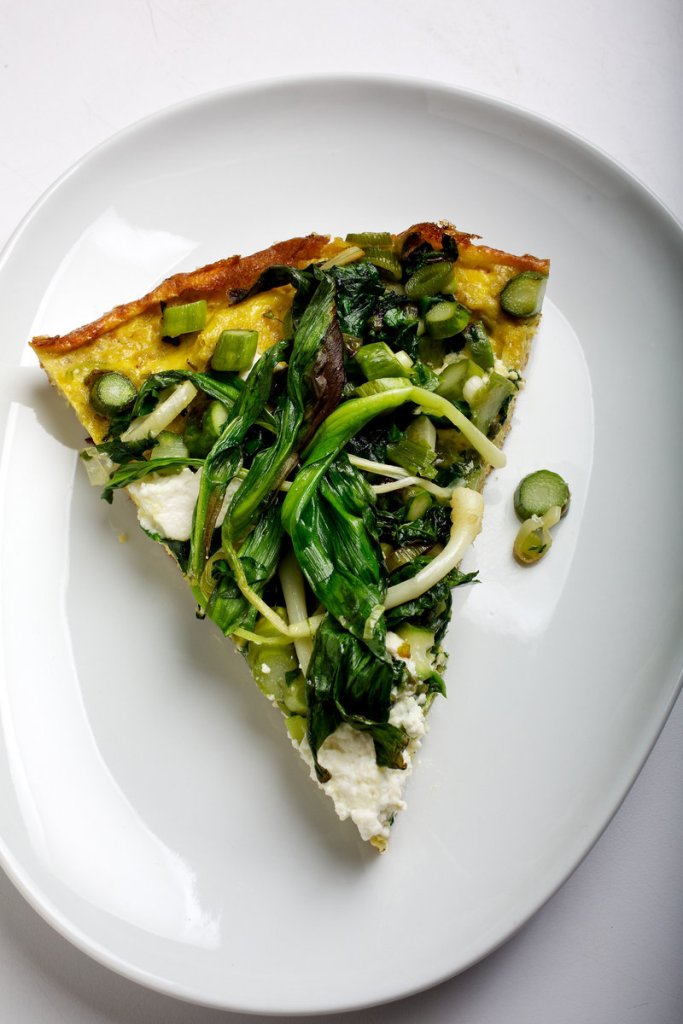Finally, seasonal vegetables other than winter greens and radishes! Besides asparagus, there’s now green garlic and ramps — and soon enough there will be fresh shelling peas. After such a long windup, the sight of my favorite spring vegetable makes me want to break into song — and to break a few eggs.
To me, nothing goes better with these young, tender, sometimes wild-foraged ingredients, so my preferred lunch or dinner when I’ve collected a bounty of them is a frittata.
Any vegan readers will have to give me a pass this week, because there’s really no substitute for those golden-yolked orbs, IMO. For ovo-lacto vegetarians (or carnivores who don’t mind skipping the meat), a frittata is one of the easiest ways to pull a dinner together I can think of, and one of the most satisfying, too.
My go-to method involves a cast-iron skillet and the broiler. Use the former to saute the vegetables, then scrape them out to make room for the eggs. After the frittata is almost set, sprinkle the cooked produce on top before sliding the skillet under the broiler to finish.
It’s a technique more than a recipe, really, which means that if you’re frustrated trying to find ramps, or you don’t want to pay top dollar for them at markets, or you can’t get your hands on green garlic (those immature stalks that haven’t developed full bulbs yet), you can put just about anything else you like on those whisked eggs.
Scallions and garlic are a good substitute for ramps, which are also members of the allium family. Other possibilities: sliced potatoes, fava beans, parsley and, if you’re not sick of them yet, winter greens and radishes. (Morels are also around, but those command a premium, so my preference is to simply cook them in the best butter I can find and sprinkle them with smoked sea salt.)
Until recently, my cheese of choice (here’s the lacto!) for a frittata was feta, until I saw a Lidia Bastianich recipe for one with ricotta. Now I put dollops of smooth, rich ricotta (whole milk, of course) right on top, creating a dish whose name sounds like it could have been a song in “The Lion King.” If “hakuna matata” means “no worries,” then I suppose Ricotta Frittata could mean “no worries, it’s spring.”
RICOTTA FRITTATA WITH SPRING VEGETABLES
Servings: Six
The vegetables can be mixed and matched as you desire and as they become available. Because the season for green garlic and ramps is short, you can substitute scallions and/or more garlic for either or both of them. Other seasonal vegetables can replace the asparagus.
Serve with a green salad.
The cooked vegetables can be refrigerated for up to five days.
8 large eggs
¼ cup whole milk
½ teaspoon sea salt, plus more to taste
2 tablespoons extra-virgin olive oil
2 cloves garlic, thinly sliced
2 stalks green garlic (may substitute 2 large scallions, thinly sliced, or 1 additional garlic clove, thinly sliced)
8 ounces asparagus (woody ends trimmed off), cut into ½-inch pieces
4 ounces baby spinach leaves, chopped
½ cup whole-milk ricotta cheese
1 small bunch ramps (may substitute 4 large scallions, thinly sliced)
Lightly beat the eggs with the milk and ½ teaspoon of salt in a mixing bowl.
Pour 1 tablespoon of the oil into a large cast-iron skillet over medium-high heat. Once the oil shimmers, add the garlic, green garlic and asparagus; cook, stirring frequently, for a few minutes, until the asparagus is barely tender. Add the spinach and cook, stirring to incorporate, just until it wilts. Season with salt to taste. Scrape the mixture into a bowl.
Position an oven rack several inches from the heating element or flame; preheat the broiler.
Return the skillet to medium-high heat. Add the remaining tablespoon of oil. Once it shimmers, pour in the egg mixture and cook for a few minutes, until it is set on the bottom.
Use a spatula to lift the edges of the eggs on one side and tilt the skillet so any uncooked egg runs underneath. Repeat on several sides until the frittata has mostly set but is still a little runny on the very top.
Spoon the garlic-vegetable mixture evenly onto the frittata. Drop tablespoons of the ricotta on the surface, and scatter the whole ramps on top.
Transfer the skillet to the oven; broil until the frittata has puffed, set and browned in spots, about 3 minutes.
Serve the frittata straight from the skillet, if desired, or run a knife around the edges and carefully invert it just long enough to flip it onto a platter so the ramps and ricotta are on top.
The frittata may deflate a bit; that is okay.
Serve warm or at room temperature.
Washington Post food editor Joe Yonan is author of “Eat Your Vegetables: Bold Recipes for the Single Cook” (Ten Speed Press), coming in August.
Send questions/comments to the editors.



Success. Please wait for the page to reload. If the page does not reload within 5 seconds, please refresh the page.
Enter your email and password to access comments.
Hi, to comment on stories you must . This profile is in addition to your subscription and website login.
Already have a commenting profile? .
Invalid username/password.
Please check your email to confirm and complete your registration.
Only subscribers are eligible to post comments. Please subscribe or login first for digital access. Here’s why.
Use the form below to reset your password. When you've submitted your account email, we will send an email with a reset code.